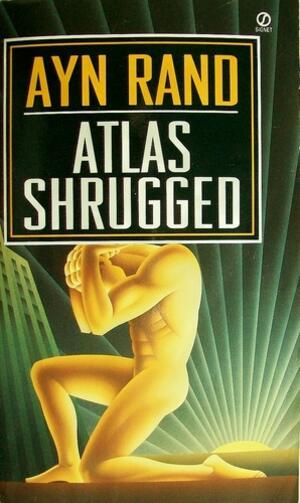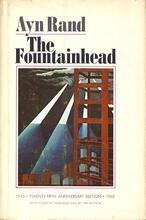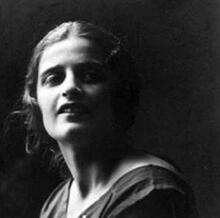Ayn Rand
Ayn Rand came of age as a university student during the Russian Revolution before immigrating to America at 21. She attempted to become a Hollywood screenwriter before the success of her Broadway play Night of January 16th enabled her to focus on writing. Her first novel, We the Living (1936), was followed by the futuristic Anthem (1938). In 1943, The Fountainhead was panned by critics but became a bestseller. As Rand’s fiction career took off, so did the development of the philosophical system she named Objectivism. Abhorring collectivism and community while advocating for reason and laissez-faire capitalism, Rand continued to lecture and write on Objectivism until her death. Her books still sell a quarter million copies per year.
Introduction
The life and work of Ayn Rand, the novelist and philosopher who promoted an ethics called “Objectivism,” provide ample evidence for those who believe that human beings are inherently self-contradictory and illogical. In her novels, Rand glorified the self-made man who aggressively demonstrated his superiority over the masses through his business acumen. As a writer, Rand had little to do with entrepreneurial activities. While she did eventually make money from her writing, she always lived frugally. Her husband of fifty years was a quiet and reserved man, never financially successful, who was happiest in his garden or painting at his easel. Her ideal physical types were tall, blond, muscular men and delicate, graceful blonde women—she herself was small, dark, and never at ease with her body. She believed passionately in the importance of the individual, yet her books developed a cultlike following among the millions of people who read them. The chief irony is that Rand became best known for her insistence on the primacy of human reason.
Early Life and Family
The eldest of three sisters, Ayn Rand was born Alyssa Rosenbaum on February 2, 1905, in St. Petersburg, Russia, to Fronz and Anna Rosenbaum. Her father, a pharmacist, had his own shop, a rare position for Jews in Russia. A precocious child, Alyssa declared herself an atheist in her early teens, and while she never denied her Jewish heritage, she also never softened her opposition to religion or any other form of “mysticism.” The privations she and her family endured as a result of the Russian Revolution, including the Bolsheviks taking possession of her father’s business, affected her deeply. Somehow she managed to survive the purges of bourgeois students long enough to obtain a degree in history from the University of Leningrad in 1924. At the university, she took a few classes in American political history and found the principles expressed in the Declaration of Independence fascinating.
Immigration to America
Despite the progressively isolationist policy of the Soviets, some Western exports still found their way to Russia in the 1920s. For Alyssa, the most important were American movies. Conditions in the United States—at least as depicted on the screen—impressed her as strongly as conditions at home repelled her, so when distant cousins provided the miraculous opportunity to travel to the United States, she did not hesitate. She turned twenty-one in Berlin, on her way to America. At immigration, she announced that her first name was Ayn (pronounced to rhyme with “pine”). Shortly after, she chose the second part of her beloved typewriter’s brand name for her surname.
Deciding that Chicago, her cousins’ home, was too provincial, Rand moved to California to write for the movies. A fluke encounter with Cecil B. DeMille on her second day in Hollywood led to a job as an extra in the film The King of Kings. This gave her a glimpse of a bit player named Frank O’Connor, the man she would marry in April 1929. But her ambition to write for the movies was not so easily fulfilled, and she scraped by for years on the salary she earned working in RKO’s wardrobe department, writing in her spare time. Her first break came with a stage play Night of January 16th, which was produced on Broadway during the 1935 season. Royalties from the modestly successful play gave her the freedom to concentrate on her writing.
Early Literary Career and The Fountainhead
Rand’s first novel, We the Living, appeared in 1936. A melodrama dismissed by most reviewers as overbearingly anti-Soviet, it quickly went out of print. Since her husband rarely worked, Rand had little but her own passion to support her during her next major project, the novel that was to become The Fountainhead. While writing The Fountainhead, Rand wrote a futuristic novella entitled Anthem about the struggle of two lovers in a collective society to reclaim the concept of a self. At the time, only a British publisher would touch it. A stage version of We the Living called The Unconquered also failed. Eventually Rand found studio work again, reading screenplays for Paramount. This job provided the contact with an editor at Bobbs-Merrill who, on the strength of the first several chapters, promised to publish The Fountainhead.
After a slow start and generally unsympathetic reviews upon its publication in May 1943, the book became a best-seller, and by the end of 1949, it had sold half a million copies. The protagonist, an architect named Howard Roark, embodied Rand’s ideal man, an individualist who would assert his own convictions in the face of complete social opposition. In the novel’s climactic scene, Roark blows up a public housing project (before occupation) rather than see his vision and plans grossly distorted. Yet Roark is not the thorough outcast he might seem. At his subsequent trial, he speaks so eloquently about his beliefs that the jury refuses to convict him. Rand wrote the screenplay for the movie version, starring Gary Cooper and Patricia Neal, which was released in 1949. The popular success of The Fountainhead established Rand’s career as a novelist and put her on secure financial ground for the first time in her life.
Literary Fame
Rand’s increasing fame brought her hundreds of fan letters and enlarged her social circle. By the early 1950s, she had cultivated a devoted coterie consisting mostly of college students and recent graduates eager to emulate her fictional heroes. Two of them, Nathan Blumenthal and his eventual wife, Barbara Weidman, apparently became so important to Rand that, in 1951, she and her husband followed them to New York City, where Rand and her husband spent the rest of their lives. In New York, Rand continued to work on what would be her last novel, Atlas Shrugged. In regular Saturday night salons, she would share portions of her work-in-progress with her group.
Rand and her husband served as witnesses at Blumenthal and Weidman’s wedding in 1953, testifying to their close relationship. In her 1986 biography of Rand, Weidman claims the dubious distinction of naming the sexual attraction between her own husband and Rand in late 1954. Once that element was acknowledged, both Rand and Blumenthal (now named Nathaniel Branden) evidently felt justified by Rand’s own tenets in embarking on an intense secret affair. According to Rand, sexual desire should go hand-in-hand with intellectual respect and shared ideals. Given their mutual interests and commitments, it was inevitable for a physical passion to develop between them—and unthinkable for it not to be fulfilled, despite their marriages and the twenty-five-year age difference. When Atlas Shrugged appeared—through Random House, after a search for a publishing house that would not cut her work— it included a joint dedication to her husband and to Branden.
Critical Response to Atlas Shrugged
Like The Fountainhead, Atlas Shrugged eventually became a best-seller. Like the earlier novel, it attracted negative reviews. Most critics found the premise of the novel—that the most gifted, creative, and successful members of a society are exploited by the untalented and unappreciative masses—only slightly less implausible than the major action of the novel, a strike of geniuses to force an end to their abuse.
Devastated by the poor critical response, exhausted from twelve years of effort, and discouraged by the thought that she might have written all she had to say, Rand withdrew. It was Branden who succeeded in restoring her confidence and supporting her second crest of fame by inaugurating regular lectures on Rand’s philosophy. Under the auspices of the Nathaniel Branden Institute, he and several other faithful students offered talks on “The Basic Principles of Objectivism,” covering subjects such as “The Nature of Emotions,” “Social Metaphysics,” “The Ethics of Altruism,” and “What is Reason?” The lectures soon drew hundreds of people in New York and expanded to several sites around the country. Sales of Atlas Shrugged continued to build—its opening sentence, “Who is John Galt?” became a popular password for those in the know—and Rand flourished in the attention. Although she herself delivered few lectures at Nathaniel Branden Institute, she did tour the country to speak on numerous college campuses. With Branden, she began a monthly called The Objectivist Newsletter, later expanded and renamed simply The Objectivist. Both versions contained essays by Rand, Branden, and other associates (including perhaps her most celebrated admirer, the economist Alan Greenspan, now chair of the Federal Reserve Board) that analyzed current political events and applied the principles of Objectivism to everyday life. The last books Rand published were collections of essays taken from the Objectivist periodicals.
Rand and the Objectivist Movement in Decline
The cohesion of the Objectivist movement shattered irrevocably, however, in 1968 when Branden finally admitted to Rand that he would not resume their long-suspended affair. In response, Rand denounced Branden, accusing him of betraying essential Objectivist principles, and forced him to sever all connections with Objectivist activities, including the institute bearing his name. Most devotees accepted her judgment and condemned Branden, even without particulars, but the upheaval occurred at a particularly inopportune moment. Rand had begun to lose her primary audience, usually young, idealistic adults, to other causes, and her customary argumentativeness in public appearances became less refreshing, more defensive and alienating. Criticism of Rand’s sexual politics began to figure as prominently as attacks on her doctrine of “rational selfishness.” The first sexual encounter in The Fountainhead between Howard Roark and Dominique Francon became emblematic of a peculiarly American romanticization of rape, at least according to feminists like Susan Brownmiller. Circulation losses pushed her to reduce The Objectivist to a smaller form again, called The Ayn Rand Letter, which appeared more and more irregularly until she ended publication in 1975.
Other personal losses took a toll as well: Her husband began to show signs of dementia years before his death in 1979, and the joyous news that her youngest and favorite sister Nora still lived led only to a brief and painfully disappointing reunion in 1973. Rand made a strong recovery from surgery for lung cancer in 1974, but she no longer had the stamina or the focus to devote herself to any large writing project.
Apart from intermittent appearances in television interviews, Ayn Rand’s last regular speaking engagement was her annual lecture at Boston’s Ford Hall Forum. Nevertheless, she had completed about one-fourth of a screenplay for a TV miniseries of Atlas Shrugged and was in the midst of preparing her next Ford Hall lecture at the time of her death, on March 6, 1982. Several hundred mourners waited in the cold to enter the Manhattan funeral home where her body was laid out, alongside a six-foot floral dollar sign, the following day. The graveside service in Valhalla, New York, consisted only of a reading of Kipling’s poem “If” before Rand was buried beside her husband.
Death and Literary Legacy
An assessment of Rand’s reputation a decade and a half after her death must account for several contradictory factors. Few professional philosophers take her work at all seriously, yet many groups of readers and fans still debate and write about her theories. Her work continues to appeal to those who search for nonreligious answers about human progress and agency. Certainly her declaration that selfishness is a virtue and altruism a vice is contrary to traditional Jewish values—yet her exaltation of personal ambition is not so different from that of many Russian Jewish immigrants of her generation who savored the relative freedom of America. Despite their dismissal by the critical establishment, her books continue to sell. Together, her novels have sold approximately twenty-five million copies, a figure that still grows by about 250,000 every year. Rand might not have succeeded in achieving the immediate influence of a crusading novelist like Harriet Beecher Stowe, as she had hoped, but her popularity today testifies to an enduring appeal.
Selected Works by Ayn Rand
Anthem (1938).
Atlas Shrugged (1957).
The Fountainhead (1943).
Night of January 16th (1936).
The Virtue of Selfishness (1965).
We the Living (1936).
Branden, Barbara. The Passion of Ayn Rand (1986).
Branden, Nathaniel. Judgment Day: My Years with Ayn Rand (1989).
Burns, Jennifer. Goddess of the Market: Ayn Rand and the American Right. Oxford: 2009.
Den Uyl, Douglas J., and Douglas B. Rasmussen, eds. The Philosophic Thought of Ayn Rand (1984).
Gladstein, Mimi Reiser. The Ayn Rand Companion (1984).
Heller, Anne Conover. Ayn Rand and the World She Made. New York: 2009.
McDowell, Edwin. “Ayn Rand: Novelist with a Message.” NYTimes, March 9, 1982, sec. 2, 6.
Pierpont, Claudia Roth. “Twilight of the Goddess.” New Yorker (July 24, 1995): 70–81.
Saxon, Wolfgang. “Ayn Rand, ‘Fountainhead’ Author, Dies.” NYTimes, March 7, 1982, 36.
Sciabarra, Chris M. Ayn Rand: The Russian Radical (1995).
Britting, Jeff. Ayn Rand (2005).





